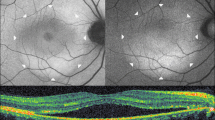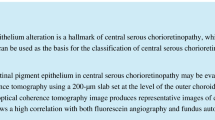Abstract
Purpose
To compare autofluorescence (AF) findings using wide-field (Optomap) and conventional (HRA-AF) confocal scanning laser ophthalmoscopy (cSLO) systems in patients with central serous chorioretinopathy (CSC), and to investigate the correlations between AF findings and functional and anatomical status.
Methods
Optical coherence tomography (OCT) and AF images were compared in 73 eyes with serous retinal detachment (SRD) (group A) and 30 eyes without SRD (group B). We evaluated AF findings from the SRD region, atrophic area, and foveola. Correlations between AF findings and outer retinal abnormalities in OCT and visual acuity (VA) were analyzed.
Results
Optomap-AF was more effective than HRA-AF in identifying the margins of a detached area (P = 0.001) in group A, and for monitoring mild outer retinal damage (P = 0.041) in group B. The foveolar AF grades in both instruments were significantly correlated with VA and central foveal thickness (CFT) in both group A (Optomap, VA r s = 0.33, P = 0.012; CFT r s = −0.38, P = 0.002; HRA, VA r s = 0.62, P < 0.001; CFT r s = −0.70, P < 0.001) and group B (Optomap, VA r s = 0.71, P < 0.001, CFT r s = −0.78, P < 0.001; HRA, VA r s = 0.40, P = 0.026, CFT r s = −0.40, P = 0.030).
Conclusions
Optomap-AF was found to be advantageous for monitoring subretinal status in eyes with SRD, and more accurately reflected mild outer retinal changes in eyes without SRD. Foveolar AF grades of both imaging modalities were significantly correlated with functional and anatomical status.



Similar content being viewed by others

References
Wang M, Munch IC, Hasler PW et al (2008) Central serous chorioretinopathy. Acta Ophthalmol 86:126–145. doi:10.1111/j.1600-0420.2007.00889.x
Spaide RF, Campeas L, Haas A et al (1996) Central serous chorioretinopathy in younger and older adults. Ophthalmology 103:2070–2079, discussion 2079–80
Matsumoto H, Kishi S, Otani T, Sato T (2008) Elongation of photoreceptor outer segment in central serous chorioretinopathy. Am J Ophthalmol 145:162–168. doi:10.1016/j.ajo.2007.08.024, e1
Matsumoto H, Sato T, Kishi S (2009) Outer nuclear layer thickness at the fovea determines visual outcomes in resolved central serous chorioretinopathy. Am J Ophthalmol 148:105–110. doi:10.1016/j.ajo.2009.01.018, e1
Aggio FB, Roisman L, Melo GB et al (2010) Clinical factors related to visual outcome in central serous chorioretinopathy. Retina 30:1128–1134. doi:10.1097/IAE.0b013e3181cdf381
Schmitz-Valckenberg S, Holz FG, Bird AC, Spaide RF (2008) Fundus autofluorescence imaging: review and perspectives. Retina 28:385–409. doi:10.1097/IAE.0b013e318164a907
Von Rückmann A, Fitzke FW, Fan J et al (2002) Abnormalities of fundus autofluorescence in central serous retinopathy. Am J Ophthalmol 133:780–786. doi:10.1016/S0002-9394(02)01428-9
Spaide RF, Klancnik JM Jr (2005) Fundus autofluorescence and central serous chorioretinopathy. Ophthalmology 112:825–833. doi:10.1016/j.ophtha.2005.01.003
Imamura Y, Fujiwara T, Spaide RF (2011) Fundus autofluorescence and visual acuity in central serous chorioretinopathy. Ophthalmology 118:700–705. doi:10.1016/j.ophtha.2010.08.017
Matsumoto H, Kishi S, Sato T, Mukai R (2011) Fundus autofluorescence of elongated photoreceptor outer segments in central serous chorioretinopathy. Am J Ophthalmol 151:617–623. doi:10.1016/j.ajo.2010.09.031, e1
Eandi CM, Ober M, Iranmanesh R et al (2005) Acute central serous chorioretinopathy and fundus autofluorescence. Retina 25:989–993
Kim S-K, Kim S-W, Oh J, Huh K (2013) Near-infrared and short-wavelength autofluorescence in resolved central serous chorioretinopathy: association with outer retinal layer abnormalities. Am J Ophthalmol 156:157–164. doi:10.1016/j.ajo.2013.02.016, e2
Iacono P, Battaqlia PM, Papayannis A et al (2015) Acute central serous chorioretinopathy: a correlation study between fundus autofluorescence and spectral-domain OCT. Graefes Arch Clin Exp Ophthalmol 253:1889–1897. doi:10.1007/s00417-014-2899-5
Lois N, Forrester JV (2012) Fundus autofluorescence. Lippincott Williams & Wilkins, Philadelphia
Nam KT, Yun CM, Kim JT et al (2015) Central serous chorioretinopathy fundus autofluorescence comparison with two different confocal scanning laser ophthalmoscopes. Graefes Arch Clin Exp Ophthalmol. doi:10.1007/s00417-015-2958-6
Tick S, Rossant F, Ghorbel I et al (2011) Foveal shape and structure in a normal population. Invest Ophthalmol Vis Sci 52:5105–5110. doi:10.1167/iovs.10-7005
Spaide RF (2008) Autofluorescence from the outer retina and subretinal space: hypothesis and review. Retina 28:5–35. doi:10.1097/IAE.0b013e318158eca4
Spaide RF (2003) Fundus autofluorescence and age-related macular degeneration. Ophthalmology 110:392–399. doi:10.1016/S0161-6420(02)01756-6
Bessho K, Gomi F, Harino S et al (2009) Macular autofluorescence in eyes with cystoid macula edema, detected with 488 nm-excitation but not with 580 nm-excitation. Graefes Arch Clin Exp Ophthalmol 247:729–734. doi:10.1007/s00417-008-1033-y
Whitehead AJ, Mares JA, Danis RP (2006) Macular pigment: a review of current knowledge. Arch Ophthalmol 124:1038–1045. doi:10.1001/archopht.124.7.1038
Bui TV, Han Y, Radu RA et al (2006) Characterization of native retinal fluorophores involved in biosynthesis of A2E and lipofuscin-associated retinopathies. J Biol Chem 281:18112–18119. doi:10.1074/jbc.M601380200
Schmitz-Valckenberg S, Fleckenstein M, Göbel AP et al (2008) Evaluation of autofluorescence imaging with the scanning laser ophthalmoscope and the fundus camera in age-related geographic atrophy. Am J Ophthalmol 146:183–192. doi:10.1016/j.ajo.2008.04.006
Waldstein SM, Hickey D, Mahmud I et al (2012) Two-wavelength fundus autofluorescence and macular pigment optical density imaging in diabetic macular oedema. Eye 26:1078–1085. doi:10.1038/eye.2012.100
Chung H, Park B, Shin HJ, Kim HC (2012) Correlation of fundus autofluorescence with spectral-domain optical coherence tomography and vision in diabetic macular edema. Ophthalmology 119:1056–1065. doi:10.1016/j.ophtha.2011.11.018
Kao T-Y, Yang C-M, Yeh P-T et al (2013) The value of combining autofluorescence and optical coherence tomography in predicting the visual prognosis of sealed macular holes. Am J Ophthalmol 156:149–156. doi:10.1016/j.ajo.2013.02.005, e1
Author information
Authors and Affiliations
Corresponding author
Ethics declarations
Funding
This research was supported by the Basic Science Research Program through the National Research Foundation of South Korea (NRF) funded by the Ministry of Education (2013R1A1A2007865). The sponsor had no role in the design or conduct of this research.
Conflict of interest
All authors certify that they have no affiliations with or involvement in any organization or entity with any financial interest (such as honoraria; educational grants; participation in speakers’ bureaus; membership, employment, consultancies, stock ownership, or other equity interest; and expert testimony or patent-licensing arrangements), or non-financial interest (such as personal or professional relationships, affiliations, knowledge or beliefs) in the subject matter or materials discussed in this manuscript.
Ethical approval
All procedures performed in studies involving human participants were in accordance with the ethical standards of the institutional and/or national research committee and with the 1964 Declaration of Helsinki and its later amendments or comparable ethical standards.
Informed consent
For this type of study (retrospective study), formal consent is not required.
Rights and permissions
About this article
Cite this article
Shin, J.Y., Choi, H.J., Lee, J. et al. Fundus autofluorescence findings in central serous chorioretinopathy using two different confocal scanning laser ophthalmoscopes: correlation with functional and structural status. Graefes Arch Clin Exp Ophthalmol 254, 1537–1544 (2016). https://doi.org/10.1007/s00417-015-3244-3
Received:
Revised:
Accepted:
Published:
Issue Date:
DOI: https://doi.org/10.1007/s00417-015-3244-3



